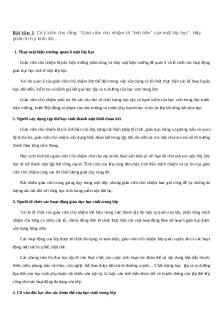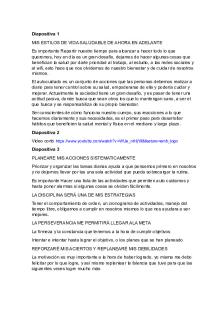DUC DDC Design STD Diapos PDF

| Title | DUC DDC Design STD Diapos |
|---|---|
| Author | Héctor Fernández |
| Course | ESR |
| Institution | Universitat Politècnica de Catalunya |
| Pages | 39 |
| File Size | 2.9 MB |
| File Type | |
| Total Downloads | 72 |
| Total Views | 154 |
Summary
Diapos clase DUC - DDC ESR. Formulas y teoría....
Description
DUC-DDC DESIGN
DIGITAL UP CONVERTER (DUC) Conceptual Scheme
Objectives: 1. Move the base-band signal to the transmission frequency fo. 2. Accommodate the base-band bandwidth to the transmission band.
DIGITAL UP CONVERTER (DUC) Spectrum LTE Signal
Notice that, for ESR, according figure and the selected sampling frequency fs=48000Hz the LTE base-band signal bandwidth is: BWBaseBand= (73/128)*48000Hz = 27375Hz.
Such number clearly claims for a reduction of transmitted bandwidth. The audio channel is useless beyond 20kHz.
DIGITAL UP CONVERTER (DUC) DUC Interpolation & Decimation DUC module implements interpolation by N and decimation by D process around the low-pas filter (LPF) of each IQ branch. This facilitates the bandwidth and sample rate adjustment by performing a global N/D interpolation. Interpolation adds N-1 zeros between two original I or Q samples before low pas filtering. Reb(n) Imb(n)
Ts
Ts
Tm
Decimation eliminates, from filter output, D-1 samples from the N ones.
The number of output samples OUT = IN·N/D, where IN is the number of input ones.
DIGITAL DOWN CONVERTER (DDC) Where v(n) is a pass-band signal allocated at fo as central frequency.
DUC/DDC INTERPOLATION DUC assumptions
fs= 48000Hz N=4 fi defines the maximum frequency of LTE bandwidth LTE 128 FFT mode: 73 non-zero carriers fi = (36/128)·48000=13500Hz With fi/4 = 3375Hz and (fs-fi)/4 = 8625Hz For LTE 128 FFT mode Uplink without PUCCH: 48 non-zero carriers fi = (24/128)·48000=9000Hz With fi/4 = 2250Hz and (fs-fi)/4 = 9750Hz
Filter design
DUC/DDC DECIMATION ecimatio
Spectrum Changes
Before decimation, filter eliminate components
Decimating D=2
DUC/DDC DECIMATION ecimatio : Time considerations
Interpolation by 4 adds 3 zeros (red samples) in the data flow. After filtering such red samples get the green values At perfect synchronisation, when decimating by D=4 we eliminate (three samples out) the green samples and ‘’theoretically’’ original blue samples remain almost the same.
DUC/DDC DECIMATION ecimatio : Time considerations
What happen when synchronisation is lost?
We choose one (orange for example) that differs from the optimal one
Distortion would appear
Improved Decimation selection criteria 1) Averaging the N/D samples 2) Looking for the set of D samples with higher energy 3) ….?
Testing DUC/DDC Implementation Testing using reference tones Input Signal: Four tones at 1.4MHz, 1.652MHz, 270kHz and 540kHz. Each with different power levels and distributed to occupy the relative LTE bandwidth. Sampling frequency 1.92MHz.
Testing DUC/DDC Implementation Testing using reference tones
Interpolation Output. Complex signal with I and Q components. Interpolation done through zero padding plus digital filtering. Interpolation level N = 8.
Interpolating by N=60.
Testing DUC/DDC Implementation Required Filters
Interpolation level N = 8.
Testing DUC/DDC Implementation Required Filters
Interpolation level N = 60.
But using the filter designed for N=8.
Testing DUC/DDC Implementation Decimation Several tones
Interpolation level N = 6 Not filtered
Interpolation level N = 6 Filtered
Interpolation level N = 6 Filtered & decimated by 2
Interpolation level N = 6 Filtered & decimated by 3
Testing DUC/DDC Implementation Combining Interpolation N & Decimation D: N/D ratio Scenario Number of samples in a subframe NofSamplesSubF= 128·14 = 1792 If CP is added NofSamplesSubF= 1920 ESR system constraints: • Transmission bandwidth TBw=3-7kHz • DAC_JACK module only accepts 1024 each timeslot. Assuming sampling frequency fs=48000Hz Signal Base band bandwidth SBBB=(36/128)·48000Hz=13500Hz
Taking as example TBw=7kHz we need to compress the SBBB by R=13500Hz·2/7kHz=3.85 Lets assume that Interpolation/Decimation process allows to compress the bandwidth.
Lets take R = 4 (only as example)
Testing DUC/DDC Implementation Combining Interpolation N & Decimation D: N/D ratio With R=4 and without CP NofSamplesSubF=1792 (Mapping Output) Only the DUC is capable to modify the samples rate by N/D=R With R=N/D=4 the number of samples at the output of DUC, NofOUTDUC=1792·4=7168 Remind DAC_JACK only accepts 1024 samples/timeslot. We need 7168/1024=7timeslots for transmitting the samples associated to a subframe. This is a valid solution for implementation purposes. Nevertheless other exist that fits N/D=4
Testing DUC/DDC Implementation Combining Interpolation N & Decimation D: N/D ratio With R=4 and with CP NofSamplesSubF=1920 (Mapping Output) With R=N/D=4 the number of samples at the output of DUC, NofOUTDUC=1920·4=7680 Then we need 7680/1024=7.5 timeslots for transmitting the samples associated to a subframe. This is a bad value. We need to coordinate the LTE specifications and inplementation issues. A solution comes from looking for a multiple of NofOUTDUC that can be exactly divided by 1024 (number of samples that accept the DAC_JACK module) or make that 1920·P=1024·S
Testing DUC/DDC Implementation Combining Interpolation N & Decimation D: N/D ratio With R=4 and with CP P=8 and S=15 is a solution. This requires to INTERPOLATE by 8 and make the MAPPING module to deliver a subframe every 15 timeslots. But TBw reduces to 3375 Hz
Wider bandwidth facilitate to achieve higher performance One option is to use P=N/D then 1920·N/D=1024·S Assuming S=7 we get N/D=8.7/15 And N=56 and D=15 satisfy the conditions: Interpolate by 56 and Decimate by 15 With that TBw = 7232Hz
Testing DUC/DDC Implementation Combining Interpolation N & Decimation D: N/D ratio Lest continue with N=56 and D=15 to test the UDC/DDC
Doing such interpolation in one step would result in strong distortion of existing signal. Notice that DUC interpolation filter, assuming a N=56 requires a very sharp filter with a bandpass around LTE_BB_bandwidth/N = 240Hz and an stop band at (fsLTE_BB_bandwidth)/N=616 Hz (assuming fs=48kHz).
Spectrum after Interpolating by 56, filtering and decimating by 15
Testing DUC/DDC Implementation Combining Interpolation N & Decimation D: N/D ratio Moving to fOL=10kHz
Now the same result but with a set of tones of equal amplitude simulating and OFDM signal as input. Notice the distortion
Testing DUC/DDC Implementation
Checking Distortion Level: Compare to well known signals Comparison done with PSS signals (DownLink). It can be done with DMRS for UpLink
Reference PSS
PSS at DDC Output
Use the Error Vector Magnitude (EVM) measurement process to compare
Testing DUC/DDC Implementation esting DUC DDC using an easy to visualize signal
Generate RAMP signal samples to be used as input of MAPPING module (instead of QAM symbols).
Notice the output of MAPPING module (figure for DownLink)
MAPPING output Pattern of 1024 RAMP samples.
MAPPING input
Testing DUC/DDC Implementation esting DUC DDC using an easy to visualize signal
Generate a RAMP signal in MAPPING module to fill the data values of a LTE frame.
Below UPLINK subframe detaill showing the DMRS signal
RAMP signal values allocated in frequency at the output of MAPPING module
Testing DUC/DDC Implementation Designing prope filte fo DUC/DDC Filter Filter 1 Stop band attenuation277 dBs
Filter of 245 taps. Introduced Delay (DUC-DDC) filters (two filters D=2) assuming an interpolation by N=4 is: Delay=(((245-1)/2)/N)·D = 61 Ts Transition band from 5400Hz to 7700Hz
It is a multiple of Ts
Testing DUC/DDC Implementation Designing prope filte fo DUC/DDC Filter Received RAMP at the output of DEMAPPING
Still with DMRS signals For reference purposes only Transition band from 5400Hz to 7700Hz
Testing DUC/DDC Implementation Now only the clean RAMP received.
Notice the perfect recovery of the RAMP signal.
Testing DUC/DDC Implementation Designing prope filte fo DUC/DDC Filter Filter 2 Stop band attenuation277 dBs
Filter of 243 taps. Introduced Delay (DUC-DDC) filters (two filters D=2) assuming an interpolation by N=4: Delay=(((243-1)/2)/N)·D = 60.75 Ts Transition band from 5400Hz to 7700Hz
It is not multiple of Ts
Testing DUC/DDC Implementation Designing prope filte fo DUC/DDC Filter Received RAMP at the output of DEMAPPING
NOTICE THE STRONG DISTORTION
Transition band from 5400Hz to 7700Hz
DUC/DDC DECIMATION ecimatio : Time considerations
What happen when synchronisation is lost?
We choose one (orange for example) that differs from the optimal one
Distortion would appear
Samples not time aligned
Testing DUC/DDC Implementation Designing prope filte fo DUC/DDC Filter Filter 3 ONLY 91dBs Attenuation at stop band 91 dBs only
Filter of 105 taps. Introduced Delay (DUC-DDC) filters (two filters D=2) assuming an interpolation by N=4: Delay=(((105-1)/2)/N)·D = 26 Ts Transition band from 5400Hz to 7700Hz
It is multiple of Ts
Testing DUC/DDC Implementation Designing prope filte fo DUC/DDC Filter
NOTICE ...SMALL DISTORTION
Transition band from 5400Hz to 7700Hz
Testing DUC/DDC Implementation Designing prope filte fo DUC/DDC Filter Filter 4 ONLY 91dBs
Moving transition band to left
Attenuation at stop band 91 dBs only Transition band reduced to 4400Hz to 6700Hz
Filter of 105 taps. Introduced Delay (DUC-DDC) filters (two filters D=2) assuming an interpolation by N=4: Delay=(((105-1)/2)/N)·D = 26 Ts It is multiple of Ts
Testing DUC/DDC Implementation Designing prope filte fo DUC/DDC Filter
NOTICE ... STRONGER DISTORTION
Transition band from 4400Hz to 6700Hz
Testing DUC/DDC Implementation Filte Requirement fo DUC/DDC Uplink (FFT 128) N=4 With PUCCH
3375Hz
8625Hz
24000Hz
2250Hz
9750Hz
24000Hz
Withou PUCCH
Testing DUC/DDC Implementation Filte Requirement fo DUC/DDC Uplink (FFT 256) N=4 With PUCCH
4219Hz
7781Hz
24000Hz
3656Hz
8343Hz
24000Hz
Withou PUCCH
Testing DUC/DDC Implementation Ideal Signal
IF Filter
0
fo
fs/2
fs-fo
fs
Multiply by 𝑒 −𝑗ωot
DDC Process
0
fs/2
fs
Interpolate by 2
0
fs/2
fs
Filter to remove this component
0
fs/2
fs
Testing DUC/DDC Implementation IF Filter
0
fo
fs/2
fs-fo
fs
Multiply by 𝑒 −𝑗ωot
0
fs/2
fs
Interpolate by 2
0
fs/2
fs
Filter to remove this component Undesired signal still present 0
fs/2
fs
Testing DUC/DDC Implementation IF Filter
0
fo
fs/2
fs-fo
fs
Multiply by 𝑒 −𝑗ωot
0
fs/2
fs
Interpolate by 2
0
fs/2
fs
Filter to remove this component Undesired signal strongly reduced 0
fs/2
fs...
Similar Free PDFs

DUC DDC Design STD Diapos
- 39 Pages

STD Group Quiz - STD Quiz
- 2 Pages

1524801040002 Vo Duc Khanh
- 60 Pages

ACMV DIGITAL DIRECT CONTROL ( DDC )
- 26 Pages

Api std 53 - API STD 53
- 164 Pages

Tesis sobre DDC - Nota: D2
- 50 Pages

STD - State Transition Diagram
- 5 Pages

IEEE Std - NINGUN
- 27 Pages

Chuong 3 dao duc-TNXH
- 43 Pages

3492 Truong Duc Hiep 9910
- 36 Pages

Diapos Gerencia de Tic Yamil
- 5 Pages

Cours protides-S1 JFSC 17-18-Diapos
- 29 Pages

PANDUAN PENOMORAN BUKU MENURUT DDC
- 93 Pages

GIAO DUC HOC DAI CUONG
- 5 Pages
Popular Institutions
- Tinajero National High School - Annex
- Politeknik Caltex Riau
- Yokohama City University
- SGT University
- University of Al-Qadisiyah
- Divine Word College of Vigan
- Techniek College Rotterdam
- Universidade de Santiago
- Universiti Teknologi MARA Cawangan Johor Kampus Pasir Gudang
- Poltekkes Kemenkes Yogyakarta
- Baguio City National High School
- Colegio san marcos
- preparatoria uno
- Centro de Bachillerato Tecnológico Industrial y de Servicios No. 107
- Dalian Maritime University
- Quang Trung Secondary School
- Colegio Tecnológico en Informática
- Corporación Regional de Educación Superior
- Grupo CEDVA
- Dar Al Uloom University
- Centro de Estudios Preuniversitarios de la Universidad Nacional de Ingeniería
- 上智大学
- Aakash International School, Nuna Majara
- San Felipe Neri Catholic School
- Kang Chiao International School - New Taipei City
- Misamis Occidental National High School
- Institución Educativa Escuela Normal Juan Ladrilleros
- Kolehiyo ng Pantukan
- Batanes State College
- Instituto Continental
- Sekolah Menengah Kejuruan Kesehatan Kaltara (Tarakan)
- Colegio de La Inmaculada Concepcion - Cebu

